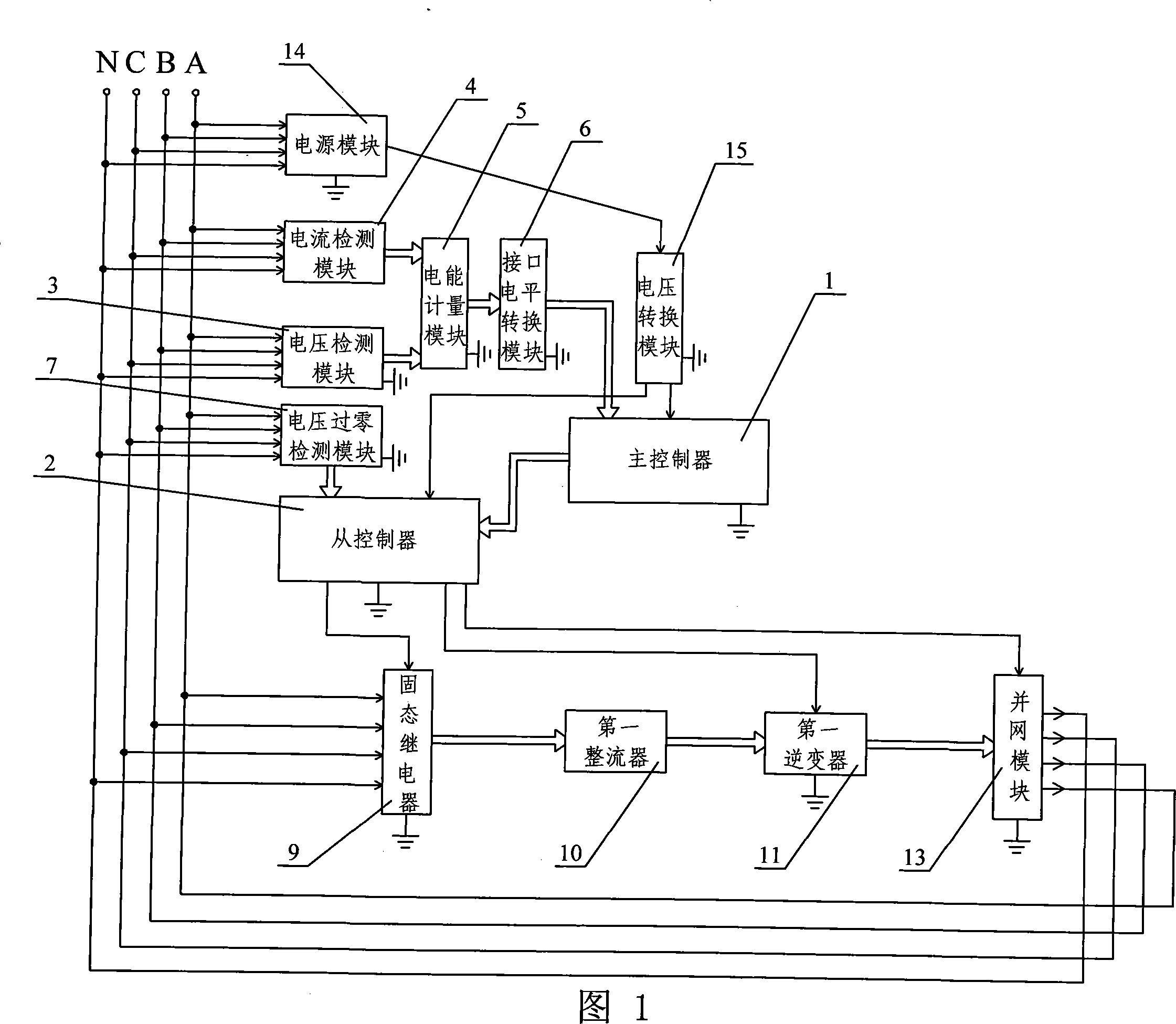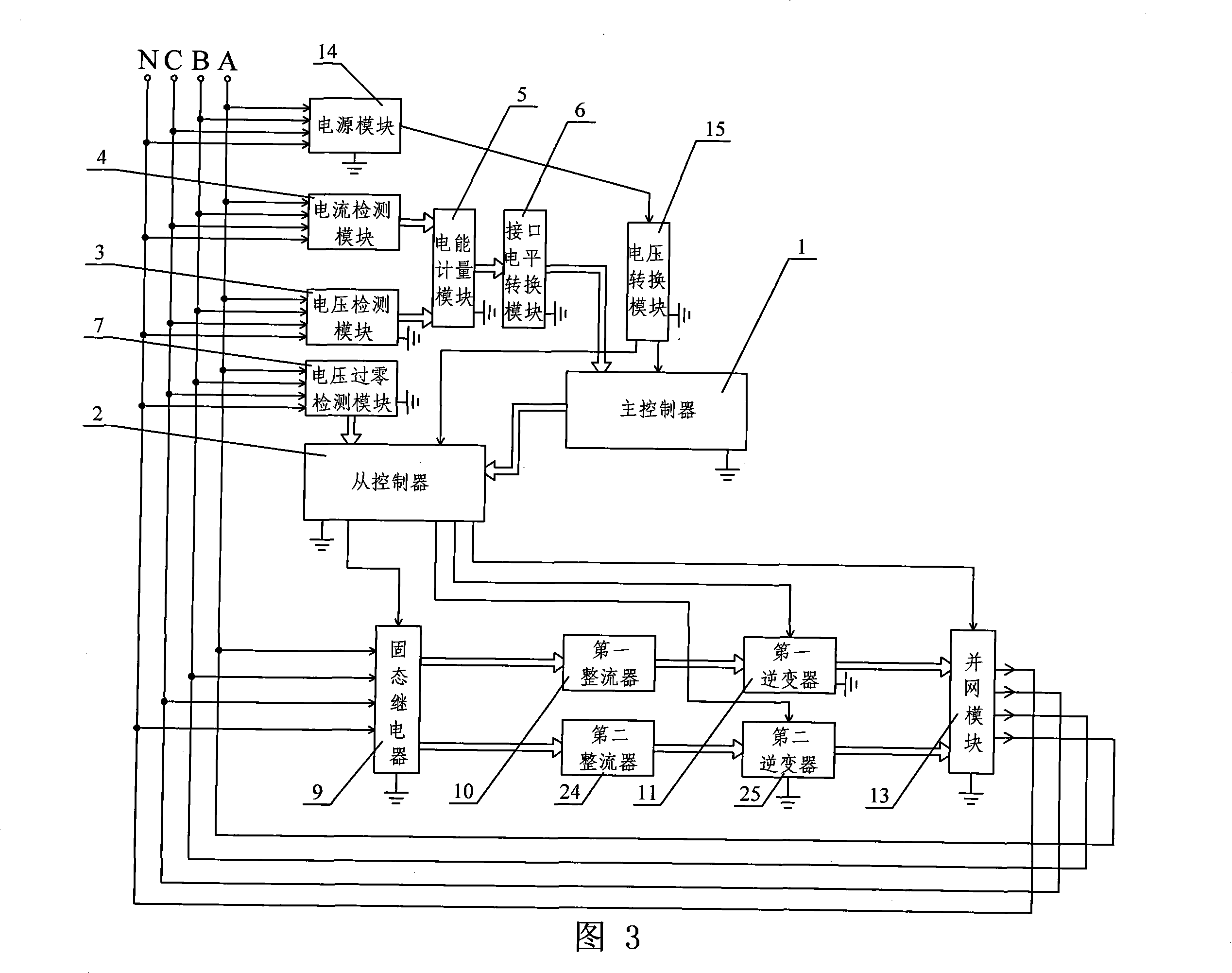Three-phase load automatic equalization device of power distribution network
An automatic balancing and three-phase load technology, which is applied in the direction of reducing the asymmetry of the multi-phase network, eliminating/reducing the asymmetry of the multi-phase network, etc., can solve the problems of shutdown of power consumption units, delay of normal production, time-consuming and labor-intensive problems, etc. The effect of long service life, reducing line loss and convenient construction
- Summary
- Abstract
- Description
- Claims
- Application Information
AI Technical Summary
Problems solved by technology
Method used
Image
Examples
specific Embodiment approach 1
[0006] Specific embodiment 1: Referring to Figure 1, this embodiment consists of a master controller 1, a slave controller 2, a voltage detection module 3, a current detection module 4, an electric energy metering module 5, an interface level conversion module 6, and a voltage zero-crossing detection module 7. The solid state relay 9, the first rectifier 10, the first inverter 11, the grid-connected module 13, the power module 14 and the voltage conversion module 15 are composed, and the four input terminals of the voltage detection module 3 are respectively connected with A, Phases B, C and N are connected, the output terminal of the voltage detection module 3 is connected to the voltage detection input terminal of the electric energy metering module 5, and the four input terminals of the current detection module 4 are respectively connected to phases A, B, C and N of the three-phase distribution network connected, the output end of the current detection module 4 is connected ...
specific Embodiment approach 2
[0012] Specific embodiment two: Referring to Fig. 2, this embodiment adds an overcurrent protection module 8 on the basis of the specific embodiment one, and the four input terminals of the overcurrent protection module 8 are respectively connected to A, B, C and A of the three-phase distribution network. N-phase connection, the control input terminal of the overcurrent protection module 8 is connected with the overcurrent protection control output terminal of the slave controller 2 , and the four output terminals of the overcurrent protection module 8 are respectively connected with the four input terminals of the solid state relay 9 . When the current in the three-phase distribution network is greater than the rated value of the working element, the slave controller 2 controls the overcurrent protection module 8 to complete the overcurrent protection.
specific Embodiment approach 3
[0013] Specific embodiment three: referring to Fig. 3, this embodiment increases the second rectifier 24 and the second inverter 25 on the basis of specific embodiment one, the input end of the second rectifier 24 and the second output end of the solid state relay 9 connected, the output end of the second rectifier 24 is connected to the input end of the second inverter 25, the output end of the second inverter 25 is connected to the second input end of the grid-connected module 13, and the control of the second inverter 25 The input end is connected with the second inverter control output end of the slave controller 2 . Through two sets of rectifiers and two sets of inverters, one phase can supply power to one phase, one phase can supply two phases, and two phases can supply power to one phase.
PUM
 Login to View More
Login to View More Abstract
Description
Claims
Application Information
 Login to View More
Login to View More - R&D Engineer
- R&D Manager
- IP Professional
- Industry Leading Data Capabilities
- Powerful AI technology
- Patent DNA Extraction
Browse by: Latest US Patents, China's latest patents, Technical Efficacy Thesaurus, Application Domain, Technology Topic, Popular Technical Reports.
© 2024 PatSnap. All rights reserved.Legal|Privacy policy|Modern Slavery Act Transparency Statement|Sitemap|About US| Contact US: help@patsnap.com










